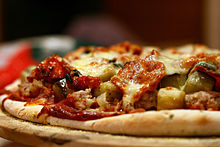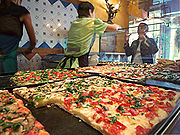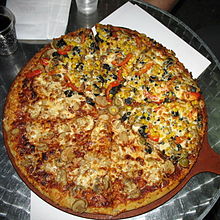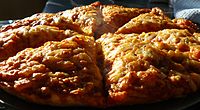- Pizza
-
part of a series on Pizza 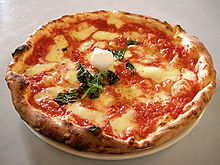 Main articlesPizza varietiesSimilar dishesDeep-fried pizza · grilled pizza · pizza bagel · calzone · coca · cong you bing · farinata · flammkuchen · focaccia · garlic fingers · lahmacun · manakish · paratha · pissaladière · quesadilla · sardenara · sausage bread · stromboliPizza tools
Main articlesPizza varietiesSimilar dishesDeep-fried pizza · grilled pizza · pizza bagel · calzone · coca · cong you bing · farinata · flammkuchen · focaccia · garlic fingers · lahmacun · manakish · paratha · pissaladière · quesadilla · sardenara · sausage bread · stromboliPizza toolsPizza
 i/ˈpiːtsə/ (Italian: [ˈpiʦ:a]) is an oven-baked, flat, disc-shaped bread typically topped with a tomato sauce, cheese and various toppings.
i/ˈpiːtsə/ (Italian: [ˈpiʦ:a]) is an oven-baked, flat, disc-shaped bread typically topped with a tomato sauce, cheese and various toppings.Originating in Italy, from the Neapolitan cuisine, the dish has become popular in many parts of the world.[1] An establishment that makes and sells pizzas is called a "pizzeria". Pizza is one of the national foods of Italy and the Italian people.
Contents
History
The Ancient Greeks covered their bread with oils, herbs and cheese. In Byzantine Greek, the word was spelled πίτα or pita, meaning pie. The word has now spread to Turkish as pide,[2] Serbo-Croatian and Bulgarian as pita, Albanian as pite and Modern Hebrew pittāh.[3] The Romans developed placenta, a sheet of flour topped with cheese and honey and flavored with bay leaves. Modern pizza originated in Italy as the Neapolitan pie with tomato. In 1889, cheese was added.[4]
King Ferdinand I (1751–1825) is said to have disguised himself as a commoner and, in clandestine fashion, visited a poor neighborhood in Naples. One story has it that he wanted to sink his teeth into a food that the queen had banned from the royal court—pizza.[5]
In 1889, during a visit to Naples, Queen Margherita of Italy was served a pizza resembling the colors of the Italian flag, red (tomato), white (mozzarella) and green (basil). This kind of pizza has been named after the Queen as Pizza Margherita.[citation needed]
Base and baking methods
The bottom of the pizza, called the "crust", may vary widely according to style—thin as in a typical hand-tossed pizza or Roman pizza, or thick as in a typical pan pizza or Chicago-style pizza. It is traditionally plain, but may also be seasoned with garlic, or herbs, or stuffed with cheese.
In restaurants, pizza can be baked in an oven with stone bricks above the heat source, an electric deck oven, a conveyor belt oven or, in the case of more expensive restaurants, a wood- or coal-fired brick oven. On deck ovens, the pizza can be slid into the oven on a long paddle, called a peel, and baked directly on the hot bricks or baked on a screen (a round metal grate, typically aluminum). When made at home, it can be baked on a pizza stone in a regular oven to reproduce the effect of a brick oven. Another option is grilled pizza, in which the crust is baked directly on a barbecue grill. Greek pizza, like Chicago-style pizza, is baked in a pan rather than directly on the bricks of the pizza oven.
Pizza types
Neapolitan pizza (pizza napoletana): Authentic Neapolitan pizzas are typically made with tomatoes and Mozzarella cheese. They can be made with ingredients like San Marzano tomatoes, which grow on the volcanic plains to the south of Mount Vesuvius, and mozzarella di bufala Campana, made with the milk from water buffalo raised in the marshlands of Campania and Lazio in a semi-wild state (this mozzarella is protected with its own European protected designation of origin).[6] According to the rules proposed by the Associazione Vera Pizza Napoletana, the genuine Neapolitan pizza dough consists of wheat flour (type 0 or 00, or a mixture of both), natural Neapolitan yeast or brewer's yeast, salt and water. For proper results, strong flour with high protein content (as used for bread-making rather than cakes) must be used. The dough must be kneaded by hand or with a low-speed mixer. After the rising process, the dough must be formed by hand without the help of a rolling pin or other machine, and may be no more than 3 mm (⅛ in) thick. The pizza must be baked for 60–90 seconds in a 485 °C (905 °F) stone oven with an oak-wood fire.[7] When cooked, it should be crispy, tender and fragrant. There are three official variants: pizza marinara, which is made with tomato, garlic, oregano and extra virgin olive oil (although most Neapolitan pizzerias also add basil to the marinara), pizza Margherita, made with tomato, sliced mozzarella, basil and extra-virgin olive oil, and pizza Margherita extra made with tomato, mozzarella from Campania in fillets, basil and extra virgin olive oil.
The pizza napoletana is a Traditional Speciality Guaranteed (Specialità Tradizionale Garantita, STG) product in Europe.[8][9]Lazio style: Pizza in Lazio (Rome), as well as in many other parts of Italy, is available in two different styles: (1) Take-away shops sell pizza rustica or pizza al taglio. This pizza is cooked in long, rectangular baking pans and relatively thick (1–2 cm). The crust is similar to that of an English muffin, and the pizza is often cooked in an electric oven. It is usually cut with scissors or a knife and sold by weight. (2) In pizza restaurants (pizzerias), pizza is served in a dish in its traditional round shape. It has a thin, crisp base quite different from the thicker and softer Neapolitan style base. It is usually cooked in a wood-fired oven, giving the pizza its unique flavor and texture. In Rome, a pizza napoletana is topped with tomato, mozzarella, anchovies and oil (thus, what in Naples is called pizza romana, in Rome is called pizza napoletana).
Types of Lazio-style pizza include:
- Pizza romana (in Naples): tomato, mozzarella, anchovies, oregano, oil;
- Pizza viennese: tomato, mozzarella, German sausage, oregano, oil;
- Pizza capricciosa ("capricious pizza"): mozzarella, tomato, mushrooms, artichokes, cooked ham, olives, oil (in Rome, prosciutto raw ham is used and half a hard-boiled egg is added);
- Pizza quattro stagioni ("four seasons pizza"): same ingredients for the capricciosa, but ingredients not mixed;
- Pizza quattro formaggi ("four cheese pizza"): tomatoes, mozzarella, stracchino, fontina, gorgonzola (sometimes ricotta can be swapped for one of the last three);
- Sicilian-style pizza has its toppings baked directly into the crust. ("Sicilian" pizza in the United States is typically a different variety of product, made with a thick crust characterized by a rectangular shape and topped with tomato sauce, cheese and optional toppings. Pizza Hut's "Sicilian Pizza", introduced in 1994, is not an authentic example of the style as only garlic, basil, and oregano are mixed into the crust);
- White pizza (pizza bianca) omits the tomato sauce, often substituting pesto or dairy products such as sour cream. Most commonly, especially on the East coast of the United States, the toppings consist only of mozzarella and ricotta cheese drizzled with olive oil and spices like fresh basil and garlic. In Rome, the term pizza bianca refers to a type of bread topped with olive oil, salt and, occasionally, rosemary sprigs. It is also a Roman style to bottom the white pizza with figs, the result being known as pizza e fichi (pizza with figs);
- Grandma's Pizza (pizza alla casalinga) consists of a thin layer of dough is stretched into an oiled, square "Sicilian" pan, topped sparingly with shredded mozzarella, crushed uncooked canned tomatoes, chopped garlic and olive oil, and baked until the top bubbles and the bottom is crisp. [10]
- Ripieno or calzone is a turnover-style pizza filled with several ingredients, such as ricotta, salami and mozzarella, and folded over to form a half circle before being baked. In Italian calzone literally means "large sock", while the word ripieno actually means just "filling" and does not by itself imply a form of pizza.
- Pizza Leggera or Pizza Mezzogiorno - very thin base half a centimeter at the most, size of a large pancake with only one topping ingredient such as herbs or cheese, suitable for lunch time.
Evolving pizza
In the 20th century, pizza has become a globally accessible dish mainly due to Italian immigrants that have brought their dishes to new people with resounding success and many times in racially and culturally resistive environments.
In Australia
The usual Italian varieties are available, though more common is the style popular in America, with more and richer topping than Italian style. A common unique type is the Aussie, Australian or Australiana which has the usual tomato sauce base and mozzarella cheese with bacon and egg (seen as quintessentially Australian breakfast fare).[11] Pizzas with seafood such as prawns are also popular. In the 1980s some Australian pizza shops and restaurants began selling "gourmet pizzas", that is, pizzas with more expensive ingredients such as salmon, dill, bocconcini, tiger prawns, or unconventional toppings such as kangaroo, emu and crocodile. "Wood-fired pizzas", that is, those cooked in a ceramic oven heated by wood fuel, are well-regarded.
In Brazil
São Paulo has 6,000 pizza establishments and 1.4 million pizzas are consumed daily.[12] It is said that the first Brazilian pizzas were baked in the Brás district of São Paulo in the early part of the 20th century. Until the 1950s, they were only found in the Italian communities. Since then, pizza became increasingly popular among the rest of the population. The most traditional pizzerias are still found in the Italian neighborhoods, such as Bexiga (official name: Bela Vista). Both Neapolitan (thick crust) and Roman (thin crust) varieties are common in Brazil, with both traditional versions with tomato sauce and mozzarella as a base, as well as sweet, using banana, chocolate or pineapple toppings being offered at the end of meal like a dessert. Brazilian pizzerias offer also "brazilian" version like "pizza com catupiri" (cheese). July 10 is "Pizza Day" in São Paulo, marking the final day of an annual competition among "pizzaiolos". In Brazil, pizza quatro queijos (pizza quattro formaggi) uses mozzarella, provolone, parmesan and gorgonzola, and there is also a variety with five cheeses, which adds catupiry.
In Malaysia
Many of western Pizza restaurants have been localized, such as invention of Tom Yom Pizza, Hot and Spicy and so on. The major pizza restaurants in Malaysia are Domino's, Pizza Hut, Papa John's, Jom Pizza, and Sure Pizza.
In India
Pizza is an emerging fast food in Indian urban areas. With the arrival of branded pizza such as Domino's and Pizza Hut in early to mid-1990s, it has reached almost all major cities in India by 2010.[citation needed] There are some domestic pizza brands such as Smokin' Joes[13] and Pop-Tates.
Pizza outlets serve pizzas with several Indian-style toppings like Tandoori Chicken and Paneer. Along with Indian variations, more conventional pizzas are also eaten. Pizzas available in India range from localized basic variants available in neighborhood bakeries to gourmet pizzas with exotic and imported ingredients available at specialty Italian restaurants.
In Israel
Many Israeli and American pizza stores and chains, including Pizza Hut and Sbarro, have both kosher and non-kosher locations.[14] Kosher locations either have no meat or use imitation meat because of the Jewish religious dietary prohibition against mixing meat and dairy products, such as cheese. Kosher pizza locations must also close during the holiday of Passover, when no bread products other than matza are allowed in kosher locations.[15] Some Israeli pizza differs from pizza in other countries because of the very large portions of vegetable toppings such as mushrooms or onions, and some unusual toppings, like corn or labane (strained yogurt), and middle-Eastern spices, such as za'atar. Like most foods in Israel, pizza choices reflect multiple cultures.
In Korea
Pizza is a popular snack food in South Korea, especially among younger people.[16] Major American brands such as Domino's, Pizza Hut, and Papa John's Pizza compete against domestic brands such as Mr. Pizza and Pizza Etang, offering traditional as well as local varieties which may include toppings such as bulgogi and dak galbi. Korean-style pizza tends to be complicated, and often has nontraditional toppings such as corn, potato wedges, sweet potato, shrimp, or crab. The super-deluxe "Grand Prix" at Mr. Pizza has Cajun shrimp, bell peppers, olives, and mushrooms on one side, and potato wedges, bacon, crushed tortilla chips, and sour cream on the other side. Its potato mousse-filled cookie dough crust is sprinkled with sunflower seeds, pumpkin seeds, and raisins, and can be dipped in a blueberry sauce that is provided.
Traditional Italian-style thin-crust pizza is served in the many Italian restaurants in Seoul and other major cities. North Korea's first pizzeria opened in its capital Pyongyang in 2009.[17]
In Nepal
Pizza is becoming more popular as a fast food in the urban areas of Nepal, particularly in the capital city, Kathmandu. There are a number of restaurants that serve pizzas in Kathmandu. With the opening of a number of international pizza brands, the popularity as well as consumption has markedly increased in recent times.
In Pakistan
The first pizzerias opened up in Karachi and Islamabad in the late 1980s, with Pappasallis serving pizza in Islamabad since 1990. Pizza has gained a measure of popularity in the eastern regions of Pakistan—namely, the provinces of Sindh, Punjab, and Azad Kashmir, as well as the autonomous territory of Gilgit-Baltistan. Pizza has not penetrated into western Pakistan; of the remaining provinces and territories of Pakistan, only one (Khyber Pakhtunkhwa) has seen much of the dish, in the form of a single Pizza Hut in Peshawar.[18] In the regions where pizza is known, spicy chicken and sausage-based pizzas are very popular, as they cater to the local palate.
In the United States
Main article: Pizza in the United StatesDue to the wide influence of Italian and Greek immigrants in American culture, the US has developed regional forms of pizza, some bearing only a casual resemblance to the Italian original. Chicago has its own style of a deep-dish pizza, Detroit also has its unique twice-baked style, with cheese all the way to the crust, wheras New York City has developed its own distinct variety of thin crust pizza.
Frozen and ready-to-bake pizzas
Pizza is available frozen. Food technologists have developed ways to overcome challenges such as preventing the sauce from combining with the dough and producing a crust that can be frozen and reheated without becoming rigid. Modified corn starch is commonly used as a moisture barrier between the sauce and crust. Traditionally the dough is partially baked and other ingredients are also sometimes precooked. There are frozen pizzas with raw ingredients and self-rising crusts. A form of uncooked pizza is available from take and bake pizzerias. This pizza is created fresh using raw ingredients, then sold to customers to bake in their own ovens and microwaves.
In Sweden
Pizza arrived in Sweden with Italian guest workers and became popular around 1970. Swedish pizza is mainly of the Neapolitan type and most pizzerias in Sweden have pizzas Margherita, Capricciosa and Quattro Stagioni at the top of the menu, although with slightly altered recipes. For example, a Swedish Margherita uses Swedish hard cheese instead of mozzarella and dried oregano instead of fresh basil and a Swedish Capricciosa uses only tomato, cheese, mushrooms and ham.
One of the most popular types of pizza in Sweden is kebab-pizza, with doner kebab as the main topping. The typical side order with Swedish pizza is a pizza salad made with shredded cabbage and sometimes red pepper that's been slightly pickled in vinaigrette for a few days.
In general, swedish pizzerias are private enterprises and not franchise. Of international restaurant chains only Pizza Hut is well established, although Vapiano has three restaurants in Stockholm and Domino's have been trying to establish in southern Sweden since 2008.[19]
In Japan
American Pizza chains entered Japan in the 1970s (e.g. Shakey’s Pizza and Pizza Hut 1973, Domino’s pizza in 1985). The most popular Japanese pizza chain is Pizza La. The most popular pizza chain promoting Italian style artisanal pizza is Salvatore Cuomo. The Italian association Associazione Verace Pizza Napoletana has an independent branch in Japan. Local types of pizza have been made, for instance mochi pizza (crust made with Japanese mochi cakes).[20][21]
Similar dishes
- "Farinata" or "cecina".[22] A Ligurian (farinata) and Tuscan (cecina) regional dish made from chickpea flour, water, salt and olive oil. Also called Socca in the Provence region of France. Often baked in a brick oven, and typically weighed and sold by the slice.
- The Alsatian Tarte flambée (German: Flammkuchen) is a thin disc of dough covered in crème fraîche, onions, and bacon.
- The Anatolian Lahmacun (Arabic: laḥm bi'ajīn; Armenian: lahmajoun; also Armenian pizza or Turkish pizza) is a meat-topped dough round. The bread is very thin; the layer of meat often includes chopped vegetables.
- The Levantine Manakish (Arabic: ma'ujnāt) and Sfiha (Arabic: laḥm bi'ajīn; also Arab pizza) are dishes similar to pizza.
- The Provençal Pissaladière is similar to an Italian pizza, with a slightly thicker crust and a topping of cooked onions, anchovies, and olives.
- Calzone and stromboli are similar dishes (calzone is traditionally half-moon-shaped, while a stromboli is tube-shaped) that are often made of pizza dough rolled or folded around a filling.
- Garlic fingers is an Atlantic Canadian dish, similar to a pizza in shape and size, and made with similar dough. It is garnished with melted butter, garlic, cheese, and sometimes bacon.
Italian and European law
In Italy, there is a bill before Parliament to safeguard the traditional Italian pizza,[23] specifying permissible ingredients and methods of processing[24] (e.g., excluding frozen pizzas). Only pizzas which followed these guidelines could be called "traditional Italian pizzas" in Italy.
On 9 December 2009, the European Union, upon Italian request, granted Traditional Speciality Guaranteed (TSG) safeguard to traditional Neapolitan pizza, in particular to "Margherita" and "Marinara".[25] The European Union enacted a protected designation of origin system in the 1990s.
Health issues
Pizza can be high in salt, fat and calories. There are concerns about negative health effects.[26] Food chains, such as Pizza Hut, have come under criticism for the high salt content of some of their meals, which were found to contain more than twice the daily recommended amount of salt for an adult.[27]
European nutrition research on the eating habits of people with cancer of the mouth, oesophagus, throat or colon showed those who ate pizza at least once a week had less chance of developing cancer. Dr Silvano Gallus, of the Mario Negri Institute for Pharmaceutical Research in Milan, attributed it to lycopene, an antioxidant chemical in tomatoes, which is thought to offer some protection against cancer.[28] Carlo La Vecchia, a Milan-based epidemiologist said, "Pizza could simply be indicative of a lifestyle and food habits, in other words the Italian version of a Mediterranean diet." A traditional Mediterranean diet is rich in olive oil, fiber, vegetables, fruit, flour, and freshly cooked food. In contrast to the traditional Italian pizza used in the research, popular pizza varieties in many parts of the world are often loaded with high fat cheeses and fatty meats, a high intake of which can contribute to obesity, itself a risk factor for cancer.
Records
- The largest pizza was at the Norwood Pick 'n Pay hypermarket in Johannesburg, South Africa. According to the Guinness Book of Records the pizza was 37.4 meters (122 feet 8 inches) in diameter and was made using 500 kg of flour, 800 kg of cheese and 900 kg of tomato puree. This was accomplished on December 8, 1990.[29]
- The most expensive pizza was made by the restaurateur Domenico Crolla, and included toppings such as sunblush-tomato sauce, Scottish smoked salmon, medallions of venison, edible gold, lobster marinated in the finest cognac and champagne-soaked caviar. The pizza was auctioned for charity, raising £2,150.[30]
See also
- List of pizzerias
- Pizza farm
- Pizza saver
References
- ^ Hanna Miller "American Pie," American Heritage, April/May 2006.
- ^ Linda Civitello (2007). Cuisine and culture: a history of food and people (Paperback ed.). Wiley. p. 98. ISBN 0471741728. http://books.google.com/books?id=MBRBjBTEBHYC&printsec=frontcover&dq=history+of+cuisine#v=snippet&q=pita&f=false.
- ^ Via the Judaeo-Spanish pita. Though the Hebrew word pittāh is spelled like the Aramaic pittəṭā/pittā, which is related to Levantine Arabic fatteh, they are not connected historically. Oxford English Dictionary, 3rd edition, April 2009 s.v. 'pita'
- ^ "American Pie". American Heritage. April/May 2006. http://www.americanheritage.com/articles/magazine/ah/2006/2/2006_2_30.shtml. Retrieved 2009-07-04. "Cheese, the crowning ingredient, was not added until 1889, when the Royal Palace commissioned the Neapolitan pizzaiolo Raffaele Esposito to create a pizza in honor of the visiting Queen Margherita. Of the three contenders he created, the Queen strongly preferred a pie swathed in the colors of the Italian flag: red (tomato), green (basil), and white (mozzarella)."
- ^ A Penchant for Pizza[dubious ]
- ^ "Selezione geografica". Europa.eu.int. 2009-02-23. http://europa.eu.int/comm/agriculture/qual/it/147_it.htm. Retrieved 2009-04-02.
- ^ "Vera Pizza Napoletana Specification | Verace Pizza Napoletana". Fornobravo.com. 2004-05-24. http://www.fornobravo.com/vera_pizza_napoletana/VPN_spec.html. Retrieved 2009-04-02.
- ^ Naples pizza makers celebrate EU trademark status, BBC News, 4 February 2010, http://news.bbc.co.uk/2/hi/europe/8499611.stm
- ^ "Publication of an application pursuant to Article 8(2) of Council Regulation (EC) No 509/2006 on agricultural products and foodstuffs as traditional specialties guaranteed – Pizza napoletana (2008/C 40/08)", OJEU, 14 February 2009, http://eur-lex.europa.eu/LexUriServ/LexUriServ.do?uri=OJ:C:2008:040:0017:0025:EN:PDF
- ^ http://slice.seriouseats.com/archives/2008/09/what-is-grandma-pizza-erica-marcus-explains-once-more.html
- ^ "Additions to the Australian lexicographical record". http://andc.anu.edu.au/australian-words/lambert-additions-corrections/first.
- ^ "Capital da pizza, sabores para todos / 2007-07-10 00:18:29 - 163164531 / Gazeta Mercantil". Indexet.gazetamercantil.com.br. http://indexet.gazetamercantil.com.br/arquivo/2007/07/10/330/Capital-da-pizza,-sabores-para-todos.html. Retrieved 2009-04-02.
- ^ [1]
- ^ Restaurants in Israel.
- ^ Pizza Hut revamps to survive.
- ^ http://www.media.asia/searcharticle/2009_04/Pizza-Hut-taps-Rain-to-win-back-Korean-market-share/35280
- ^ "First North Korean pizzeria opens". BBC News. 2009-03-16. http://news.bbc.co.uk/2/hi/asia-pacific/7945816.stm. Retrieved 2010-05-22.
- ^ "Foreign food franchises. (Pakistan) | Franchises from". AllBusiness.com. http://www.allbusiness.com/food-beverage/restaurants-food-service-restaurants-fast/8006760-1.html. Retrieved 2010-02-19.
- ^ "Dominos.se (Swedish)". http://www.dominos.se/. Retrieved 2011-07-10.
- ^ Ceccarini R. (2010) Food Workers as Individual Agents of Culinary Globalization: Pizza and Pizza Chefs in Japan. Sophia University, Tokyo. http://icc.fla.sophia.ac.jp/global%20food%20papers/pdf/3_3_CECCARINI.pdf
- ^ Ceccarini R. (2011) Pizza and Pizza Chefs in Japan: A Case of Culinary Globalization. Brill Publishers, Netherlands. http://www.brill.nl/pizza-and-pizza-chefs-japan-case-culinary-globalization
- ^ "Brick Oven Cecina". Fornobravo.com. http://fornobravo.com/brick_oven_cooking/brick_oven_recipes/flatbread/cecina.html. Retrieved 2009-04-02.
- ^ "Bill for traditional Italian pizza". Senato.it. http://www.senato.it/japp/bgt/showdoc/showText?tipodoc=Ddlpres&leg=13&id=00007353&offset=4504&length=6529. Retrieved 2009-04-02.
- ^ "Permissible ingredients and methods of processing". Senato.it. http://www.senato.it/leg/13/BGT/Schede/Ddliter/testi/13214_testi.htm. Retrieved 2009-04-02.
- ^ EU grants Neapolitan pizza Traditional Specialty Guaranteed label, Pizza Marketplace
- ^ "Food Standards Agency - Survey of pizzas". Food.gov.uk. 2004-07-08. http://www.food.gov.uk/science/surveillance/fsis2004branch/fsis5804. Retrieved 2009-04-02.
- ^ "Health | Fast food salt levels "shocking"". BBC News. 2007-10-18. http://news.bbc.co.uk/1/hi/health/7050585.stm. Retrieved 2009-04-02.
- ^ "Mario Negri - Istituto di Ricerche Farmacologiche". Marionegri.it. 1963-02-01. http://www.marionegri.it/mn/en/index.html. Retrieved 2009-04-02.
- ^ "Mama Lena's pizza "One" for the book... of records". Pittsburghlive.com. http://www.pittsburghlive.com/x/pittsburghtrib/s_434064.html. Retrieved 2009-04-02.
- ^ Chef cooks £2,000 Valentine pizza, BBC News.
Flatbreads Asia Barbari bread • Bazlama • Bhakri • Bhatoora • Bindaetteok • Bing • Bolani • Chapati • Dosa • Kulcha • Roast paan • Gözleme • Green onion pancake • Khanom buang • Laobing • Luchi • Malooga • Markook • Matzo • Naan • Papadum • Paratha • Pesarattu • Pita • Puri • Roti • Roti canai • Sanchuisanda • Sangak • Tandyr nan • Taboon bread • Yufka
Europe Crêpe • Crisp bread • Farl • Flammkuchen • Flatbrød • Flatkaka • Focaccia • Hoggan • Lavash • Lefse • Opłatek • Pancake • Pane carasau • Piadina • Pita • Podpłomyk • Rieska • Sacramental bread • Tunnbröd
Africa Aish Mehahra • Harsha • Injera • Lahoh • Mandezi • Ngome
Americas Arepa • Bammy • Casabe • Tortilla • Tortilla de Rescoldo
Categories:- Pizzerias
- Pizza
- Italian cuisine
- Italian loanwords
- Mediterranean cuisine
- World cuisine
- Italian inventions
- Flatbreads
Wikimedia Foundation. 2010.

